 Table for One is a series focusing on solo tabletop gaming. The series will cover two flavors of solo games–games designed to be played by a single person exclusively and games that are multi-player but have a solo version. Today’s game is 7th Continent from Serious Poulp, a game currently on Kickstarter.
Table for One is a series focusing on solo tabletop gaming. The series will cover two flavors of solo games–games designed to be played by a single person exclusively and games that are multi-player but have a solo version. Today’s game is 7th Continent from Serious Poulp, a game currently on Kickstarter.
New to Kickstarter? Check out our crowdfunding primer. Please note that I received a prototype copy of the game so final components and quality will be different from what you see here.
The Game
7th Continent is for one to four players. The basic idea of the game is that you are one of the former explorers of a mysterious land (the 7th Continent) who has returned to find a way to remove the curse from your last expedition. The game is a unique mix of RPG, crafting, exploration, and, if playing with multiple players, cooperation. The game also has a novel way to “save and load” a game, just like your favorite video games. Because the full version of the game can potentially be played for many, many hours, this feature is essential. I’ll be covering the single-player flavor of the game and the introductory adventure, which is smaller than the full version of the game.

Components
Because I received a prototype with an alpha rule book, I didn’t receive the full starting set of components. The list below represents what will be included in the base game (there are already planned expansion packs that are available as add-ons) so keep that in mind when looking at the photos of my game. Also, the core set will probably end up with even more components as stretch goals keep being unlocked.
- Rulebook (PDF of Alpha Rules)
- 700+ cards
- 415+ green or yellow numbered cards
- 92 blue cards forming the Action Deck
- 110 Random event cards
- 30 Food cards
- 28 State cards
- 9 Experience point cards
- 10 Save cards
- 4 Character cards
- 3 Clue cards
- 1 Shoulder bag card
- 4 character miniatures (1 per player)
- 4 campfire miniatures (1 per player)
- 8 six-sided dice (These are counters. There is no dice rolling in this game)
- 4 player aids
- 3 storage trays and about 20 dividers to organize your cards
The component that is not critical but will certainly make the scope of the game more manageable are the storage trays. I didn’t receive those in my prototype, but even with a smaller set of cards, I could see how useful they would be. I immediately thought of the Pathfinder Adventure Card Game when reading about the storage system. The storage system promises to have a very neatly organized way of keeping track of the different card types and allowing for ease of finding cards and saving/loading your game.
There are also plenty of stretch goals and add-on expansions that add more cards, more miniatures, and more adventure.
Setup and Gameplay

Game setup is pretty easy and straightforward. You start by selecting a character and a curse. Each character has their own back story, special abilities, and five unique action cards. Each curse also has its own story and flavor as well. You take the five character action cards and shuffle those, along with the curse cards, into the action deck. Your character card and the shoulder bag are placed on the table beside you for quick reference and managing your inventory.
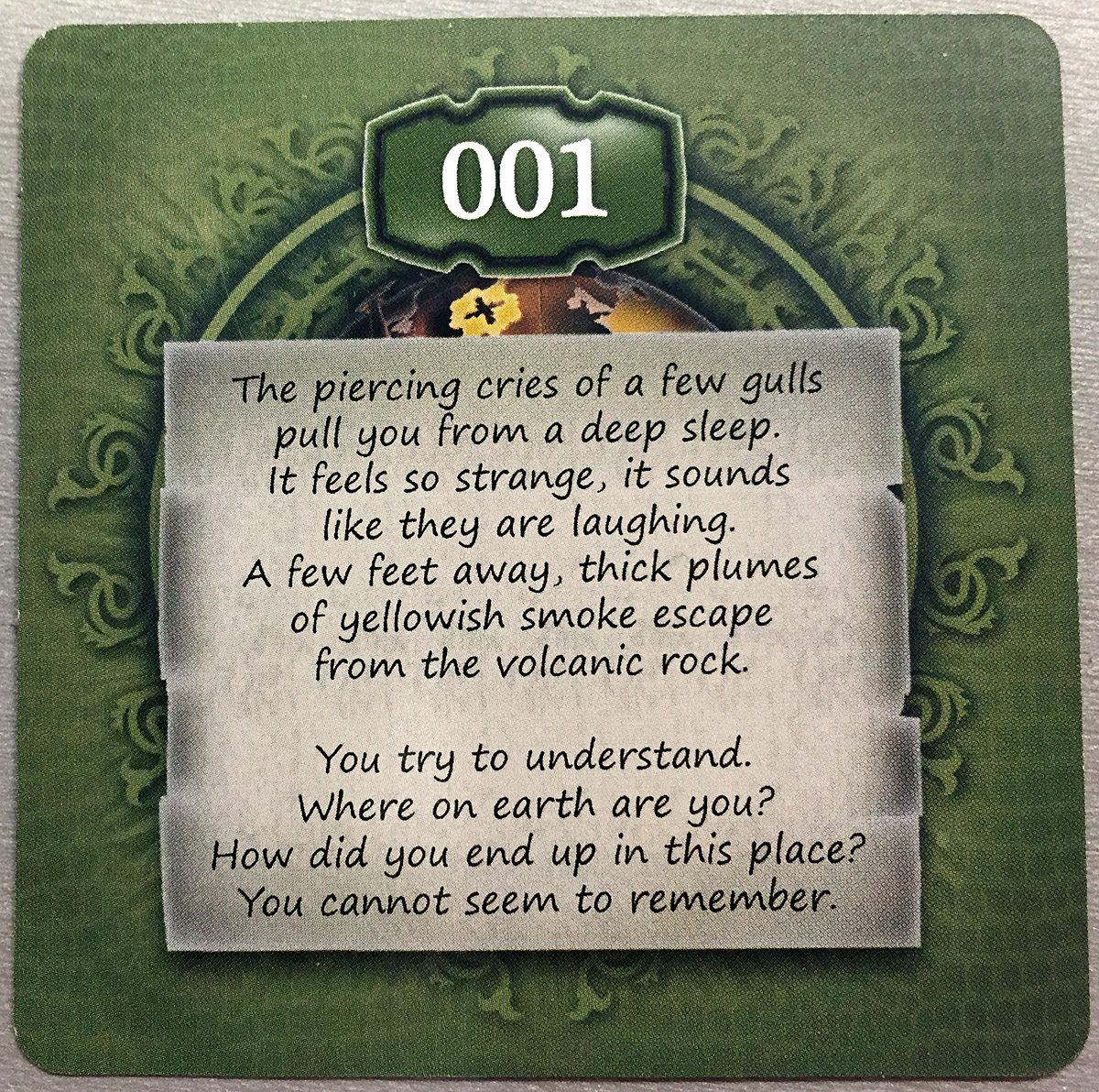 You then start with the first card, 001, from the Exploration Deck. After reading the story prompt on the back of the card, it is flipped over and placed in the center of your game area. This is the starting point for your character.
You then start with the first card, 001, from the Exploration Deck. After reading the story prompt on the back of the card, it is flipped over and placed in the center of your game area. This is the starting point for your character.
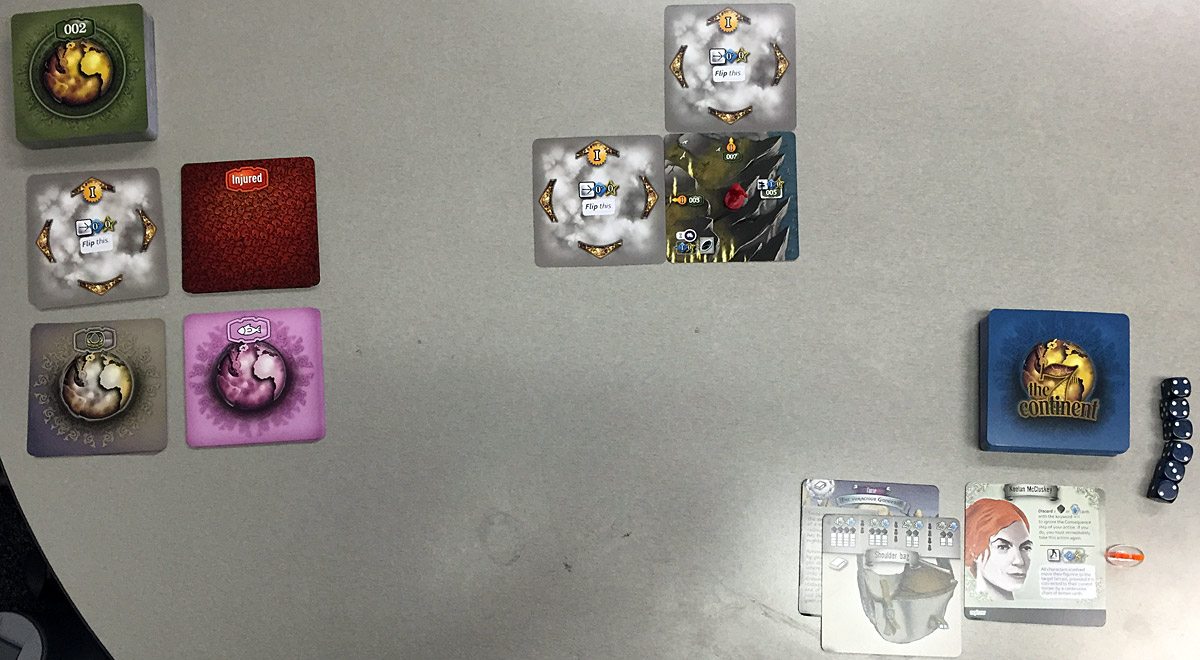
Every time you place a terrain Exploration Card, you must place random event cards at any exit point from that location (to the north and west above). Think of these as fog on the map. Before you can explore a new location, you must resolve the random event card. I’ll get into that more in a bit.
 Although there is a plethora of information on a terrain card, once you learn it, it’s very easy to see what your options are and what you can choose to do. The yellow arrows and green numbers show you which directions you can explore and which numbered card goes in that space once you’ve explored. This card also has, on the right side, a “go and see/visit” action and, in the bottom left corner, a stone resource that can be used.
Although there is a plethora of information on a terrain card, once you learn it, it’s very easy to see what your options are and what you can choose to do. The yellow arrows and green numbers show you which directions you can explore and which numbered card goes in that space once you’ve explored. This card also has, on the right side, a “go and see/visit” action and, in the bottom left corner, a stone resource that can be used.
A turn is broken down into choosing an action and then taking the Action steps to resolve it. The six action steps are:
- Item. Using an item will reduce its durability by one and will usually give you a specific boost to a specific type of action.
- Cost. Determine an actions cost by the number in the blue diamond. This is the minimum number of cards you must draw from the action deck, modified by any bonuses you may have from your item.
- Result. Flip your cards and combine the success stars with any you may have gained from your items to determine if you succeeded or failed.
- Idea. You can add one of the idea cards (card with a blue hand icon in the upper left) to your hand from the draw pile assuming you are not at your limit.
- Discard. All other cards are discarded.
- Consequence. If you succeeded, follow the result in the white box. If you failed, follow the result in the black box.
Pretty straightforward and simple, right? But even with those simple rules, the variety of actions, events, cards, and randomness allows for incredible depth and complexity.
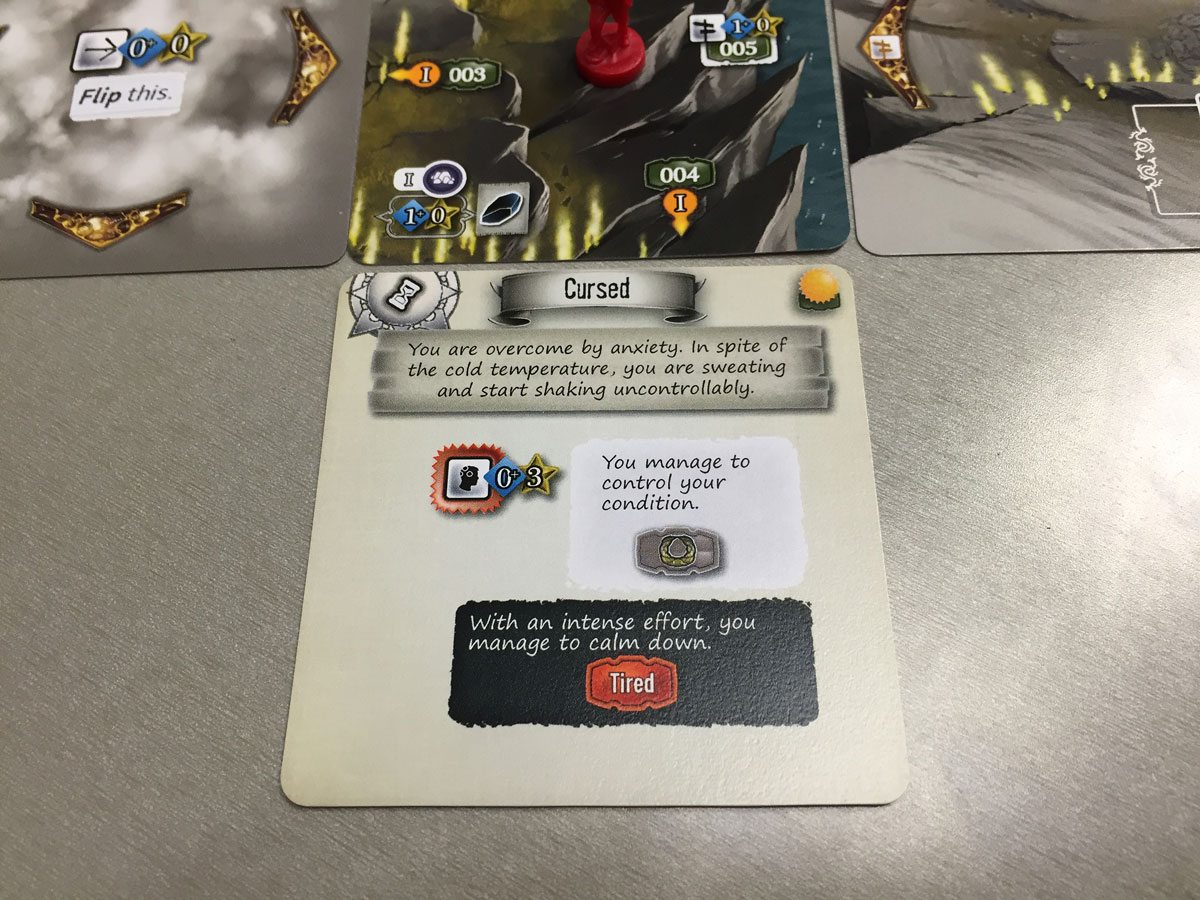 Here is a sample turn of mine. I explored one of the random event cards (which are all free actions), and received this curse card. An action outlined with a red burst must be taken immediately. I needed three stars to succeed and could choose to draw zero or more cards. This early in the game, I had no items and decided to draw two cards from my action deck. Unfortunately, I didn’t get the needed three stars and so was “awarded” a Tired state card.
Here is a sample turn of mine. I explored one of the random event cards (which are all free actions), and received this curse card. An action outlined with a red burst must be taken immediately. I needed three stars to succeed and could choose to draw zero or more cards. This early in the game, I had no items and decided to draw two cards from my action deck. Unfortunately, I didn’t get the needed three stars and so was “awarded” a Tired state card.
 While this Tired card doesn’t have any immediate negative effects, there are times when having a certain state can negatively impact your actions. To get rid of this state card on another turn, I would take the indicated rest action and need to get two stars to remove the state.
While this Tired card doesn’t have any immediate negative effects, there are times when having a certain state can negatively impact your actions. To get rid of this state card on another turn, I would take the indicated rest action and need to get two stars to remove the state.
So why not just draw more cards and always succeed at my actions and eliminate negative states? Well, another important mechanic of the game, probably the most important, is that the action deck can be thought of as your character’s health. For those familiar with Pathfinder ACG it’s sort of like a combination of your character deck and the blessings deck. There are cards that allow you to “heal” cards from the action card discard back to the deck, and running out of action cards doesn’t instantly kill you.
But remember those purple curse cards that got shuffled in? While they don’t really have much purpose while going through your action deck (other than wasting a draw), once your action deck runs out, you must draw cards from your discard pile to complete actions. If you hit one of those curse cards, you succumb to your curse and it’s game over. It adds a bit more uncertainty to when time will run out and when exactly you may die. You also have to be careful to not burn through your action deck–sometimes failing an action is better than using up too many cards.
 After resolving my turn and taking my state, I placed the appropriate numbered card onto my game space revealing a lot more actions and more stuff to explore. The first step after placing a terrain card is to place random events next to any exits (the left side in this case). On my next turn, I can now move to this terrain. The cost to move to a new space is indicated in the bottom left–2+ in this case, no stars required for success.
After resolving my turn and taking my state, I placed the appropriate numbered card onto my game space revealing a lot more actions and more stuff to explore. The first step after placing a terrain card is to place random events next to any exits (the left side in this case). On my next turn, I can now move to this terrain. The cost to move to a new space is indicated in the bottom left–2+ in this case, no stars required for success.
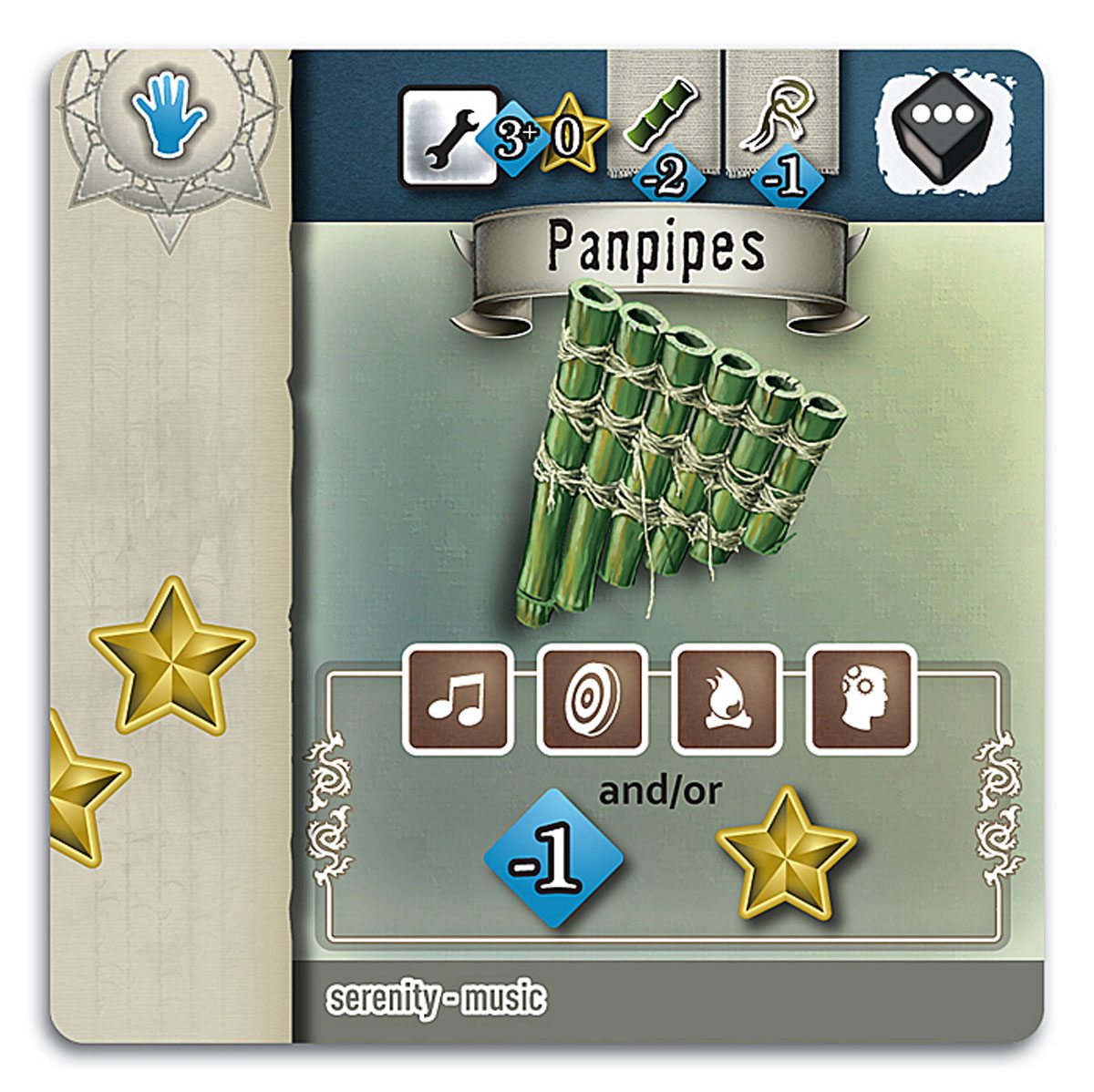 You may be wondering what exactly the resource on terrain is for, and that’s exactly where I’m headed–crafting. For your turn, instead of doing anything with the board itself, you can choose to craft an item in your hand. Each item card has four important things to note–the starting durability in the upper right corner, the cost to build across the top, the actions it can be used for and what you get for using it on the bottom, and the keywords along the bottom edge.
You may be wondering what exactly the resource on terrain is for, and that’s exactly where I’m headed–crafting. For your turn, instead of doing anything with the board itself, you can choose to craft an item in your hand. Each item card has four important things to note–the starting durability in the upper right corner, the cost to build across the top, the actions it can be used for and what you get for using it on the bottom, and the keywords along the bottom edge.
The cost to craft an item can be reduced if you are on a square with the resources indicated (bamboo or rope in this case), but the beauty of the crafting system is that you do not need the resources. This allows you to always craft (unless you run out of cards in your action deck) but at a higher cost to your character and chances of survival.
The durability of an item is pretty self-explanatory–you track it with one of the included die, and it goes down every time you use it until it is expended.
The reward from using an item is also pretty self-explanatory. If you are attempting one of the listed actions (playing music, hunting, making a fire, or thinking) you can use this item to reduce the amount of cards required to draw or automatically get one success star.
The final piece to keep an eye on are the keywords. Some cards and events will apply only to cards with certain keywords, but the more important purpose is for combining items in your inventory. In a single player game, you have four inventory slots. Each slot can be made up of up to four items. However, you can only combine items that have at least one matching keyword. When you combine items in your inventory, the durability of the items is added together and is for the entire group but can never go over six.
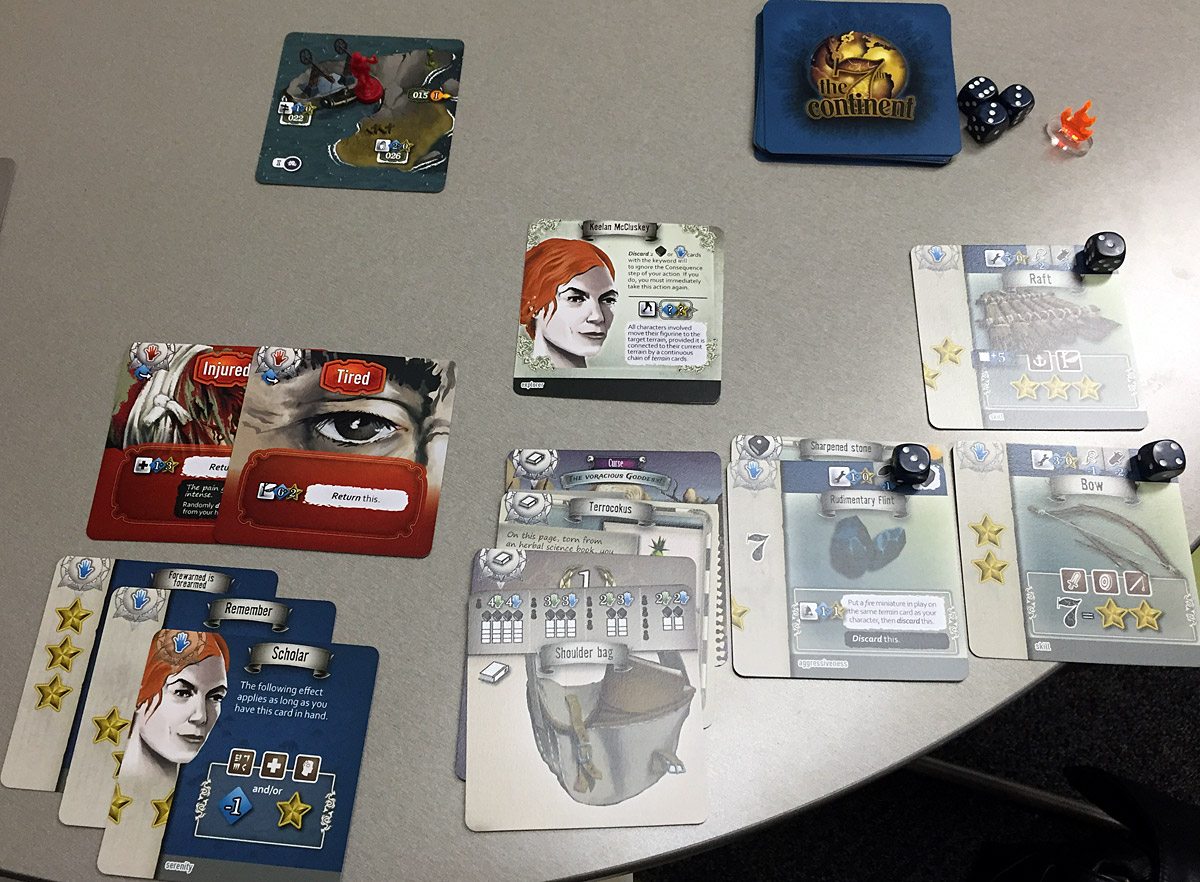
This was the state of my game when I finally needed to pack up. Three items, two state cards, three notes, and four inventory items.
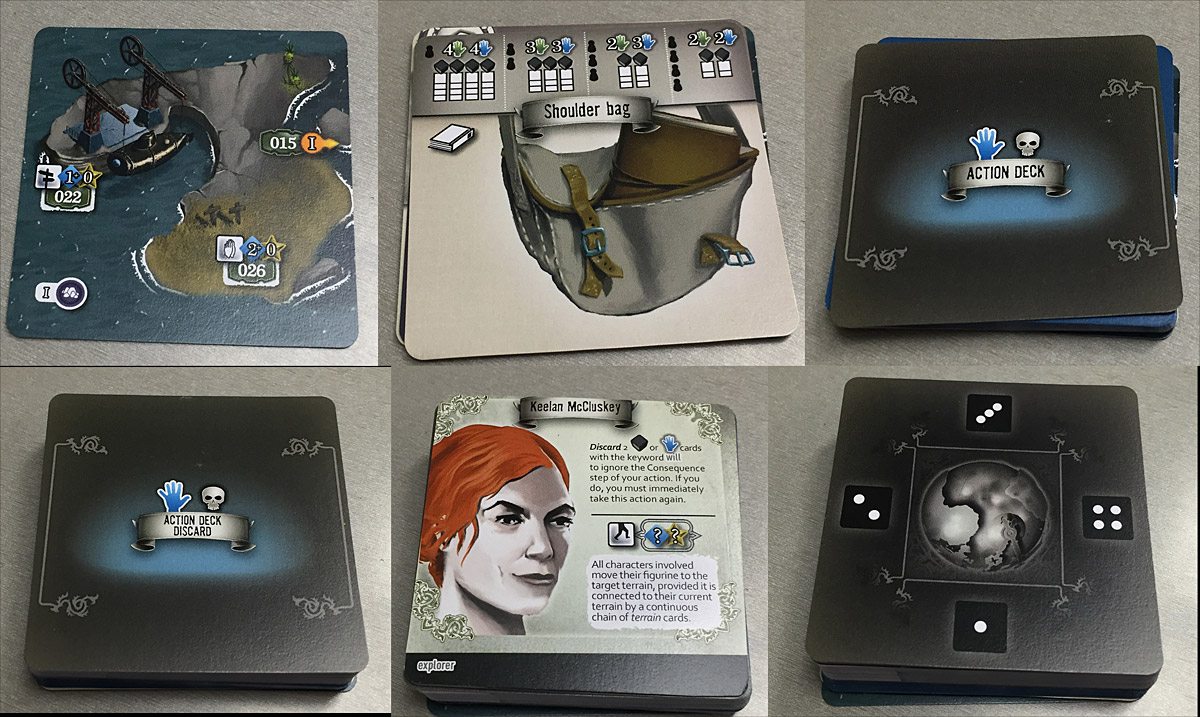 Saving your game is dead simple. First you discard all terrain except for the one you are on (the 7th Continent is always changing and mysterious) and then stack the cards in the following order–your terrain card, the shoulder bag card on top of any note cards, the action deck divider card on top of your action deck, the action deck discard divider card on top of your action deck discard pile, your character card, and your inventory items with a card indicating each item’s, or item group’s, current durability. Saving my game literally took me two-minutes and that included taking pictures. Making it this easy to save and load a game is a huge win.
Saving your game is dead simple. First you discard all terrain except for the one you are on (the 7th Continent is always changing and mysterious) and then stack the cards in the following order–your terrain card, the shoulder bag card on top of any note cards, the action deck divider card on top of your action deck, the action deck discard divider card on top of your action deck discard pile, your character card, and your inventory items with a card indicating each item’s, or item group’s, current durability. Saving my game literally took me two-minutes and that included taking pictures. Making it this easy to save and load a game is a huge win.
There are even more game details and mechanics I haven’t yet experienced so didn’t cover in detail, especially where rules vary slightly for cooperative play. For even more in-depth gameplay videos and game details, Serious Poulp has multiple videos on their Kickstarter.
The Verdict
After playing 7th Continent for a couple of hours now (my game is currently saved until I can continue later), I had to stop and there is only one important question on my mind–when can I get the rest of the cards?! I really love this game. There is so much depth to the game, but once you learn the rules, it’s a very easy to play game. After my first glance at the rules, I really thought it was going to be a lot harder to play and that I’d be bogged down in the game mechanics. I wish I didn’t have other stuff to do right now because I’d rather keep playing! If you enjoy games full of adventure, exploration, story, replayability, fun and unique game mechanics, and great value for your money, you will not be disappointed if you back 7th Continent.
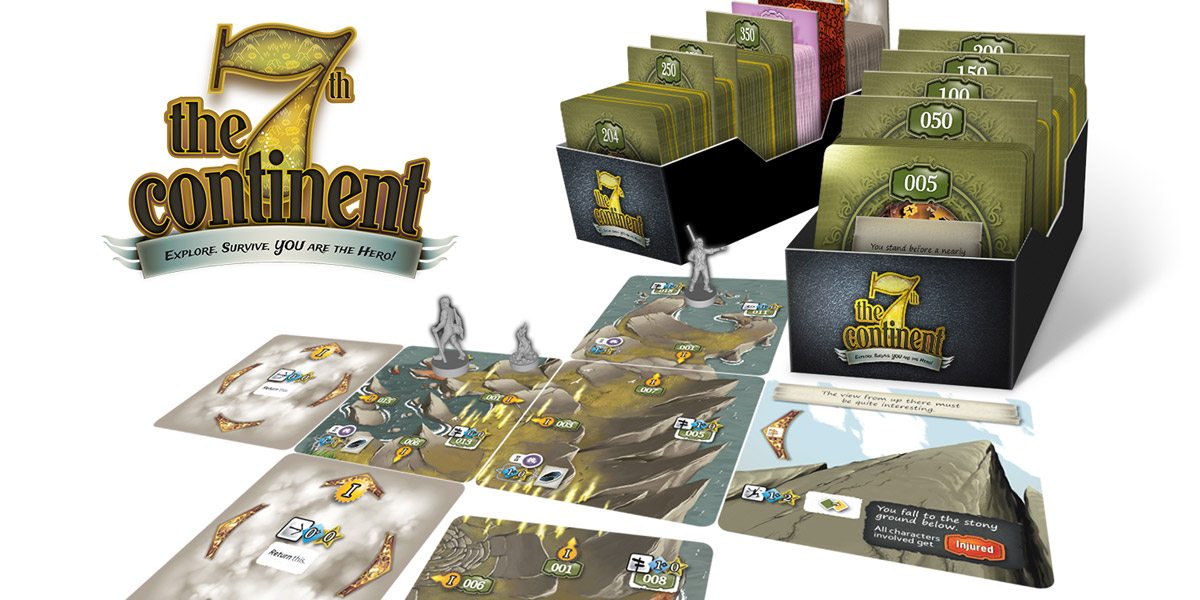

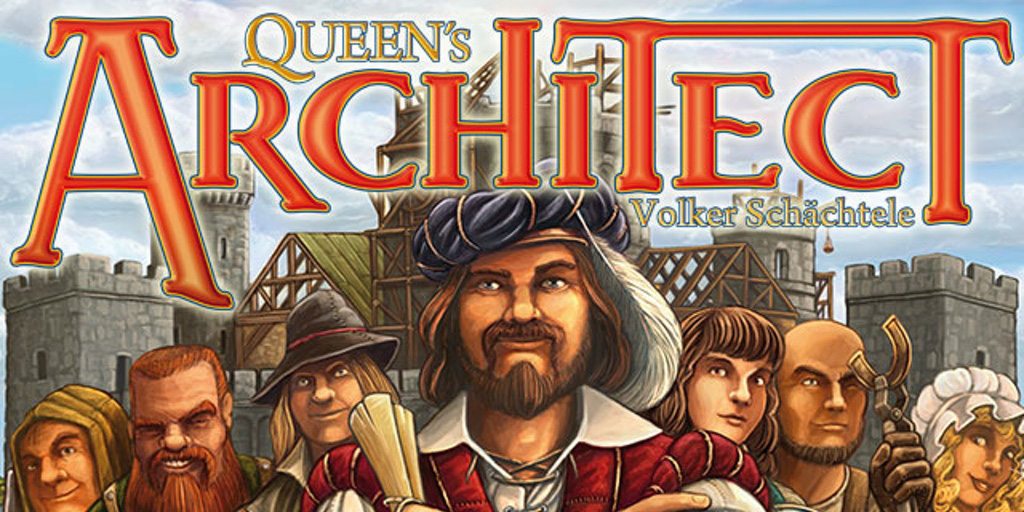


Do you have any more images of the game?
Those are all of the pics I have from my own playing but there are a lot of pictures and videos of the game on the Kickstarter page. Let me know if you have any other questions and thanks for reading!